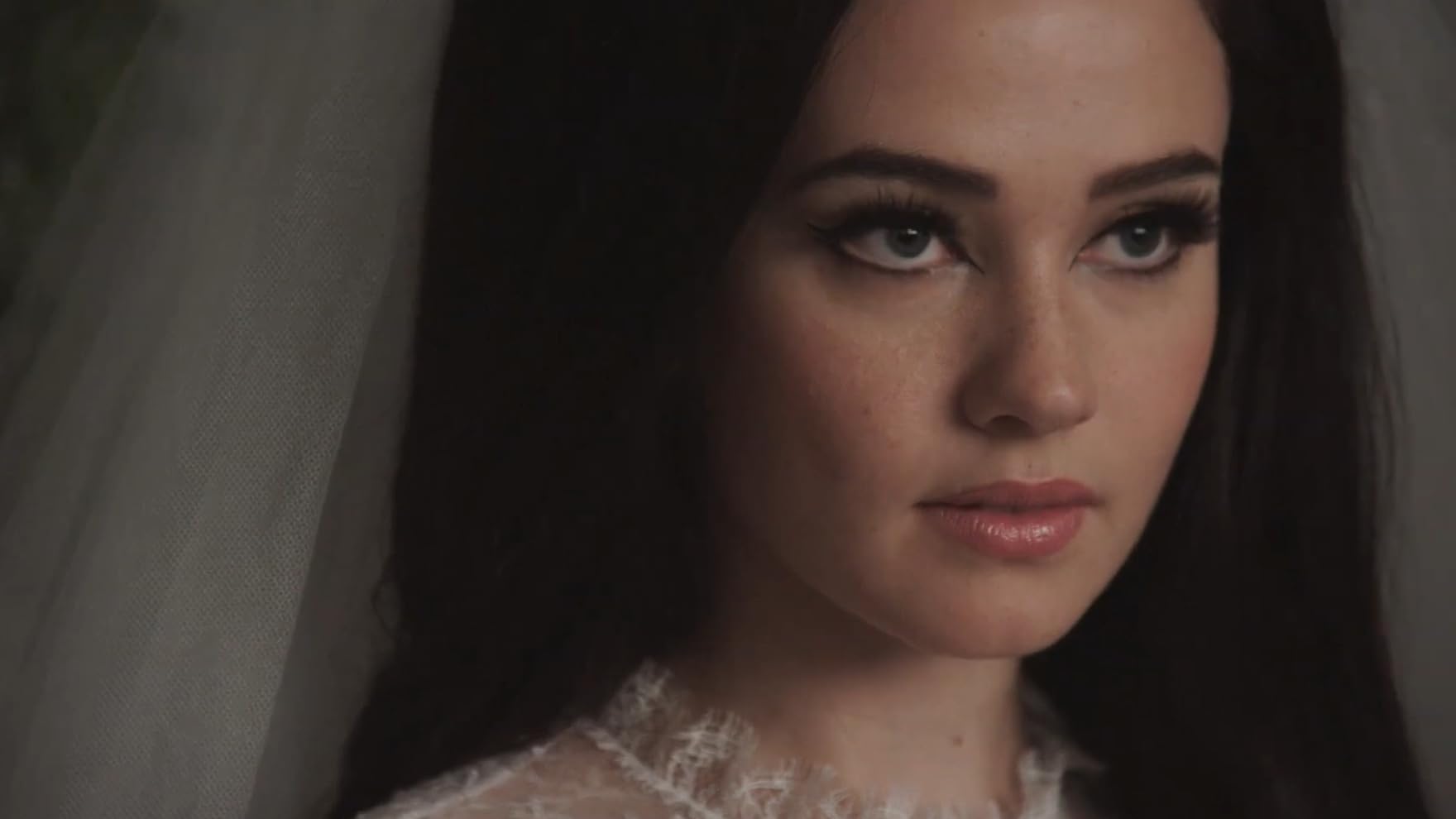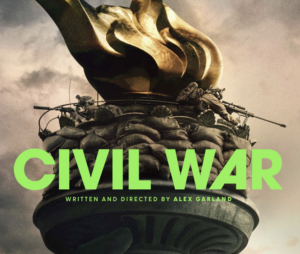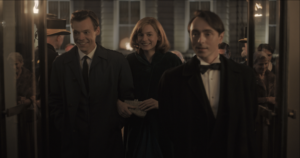As Priscilla Beaulieu (soon to be Presley) navigates the realms between innocence and infatuation, she gently traces a heart around her and Elvis Presley’s names. This snapshot of girlhood, familiar to so many lovesick teens, subtly foreshadows the romance and entrapment that jointly defines the fabric of their iconic relationship.
Sofia Coppola’s adaptation of Priscilla Presley’s memoir Elvis and Me (1985) unveils the delicate dance between dreams and despair that characterized most of Priscilla’s lifetime, a tale that exposes the glamorized lures of love and belonging that infiltrated her girlhood, unfolding against the backdrop of Elvis Presley’s stardom.
Priscilla (2023) begins when Priscilla (Cailee Spaeny) is a high school freshman living with her family in West Germany, where her father is stationed in the U.S. military. Elvis Presley (Jacob Elordi), already a well-known name in the world of entertainment, was also stationed in West Germany at the time, a coincidence that became the catalyst for their romance. The camera weaves through the corridors of fame, following Priscilla’s journey from the moment Elvis’s friend first notices her sitting in a diner and invites her over to Elvis’s house. Critically, the film does not shy away from laying bare the uncomfortable truth of grooming that pervades the relationship from its inception. When they first meet, Priscilla is a mere 14 years old while Elvis is 24. Already, Elvis’s friend scouting Priscilla is an uncanny reminder of the power dynamics at play. From the first party Priscilla attends, Elvis never asks her to spend time alone with him—instead, it is a clear command to wait for him upstairs, not a question.
Despite their initial opposition, Priscilla’s mother Ann (Dagmara Dominczyk) and father James (Ari Cohen) are eventually won over by Elvis’s charms and convinced to let him keep seeing Priscilla. He fulfills her girlish romantic desires, putting his jacket around her and delicately clasping the bracelet he bought her on her wrist. The speed at which she is whisked off her feet by Elvis is contrasted by the way time seems to slow when she’s alone and he goes back to America. She’s distracted in school and her mental health deteriorates as she wonders whether he forgot about her. Through this juxtaposition, we see how Priscilla has become reliant on Elvis, losing a sense of identity when alone.
Coppola skillfully manipulates time throughout the film, making it not just a narrative device but a mode of immersing the audience in Priscilla’s life. Elvis’s small flashes of anger are followed immediately by some nostalgic music and retro film camera clips filled with laughter, parties, and, seemingly, love. The cycle repeats as the moments of abuse become more and more frequent; time speeds up and slows down almost routinely. The repetition is painfully apparent, and viewers start anticipating each time the next incident is around the bend. Despite the viewer’s acute awareness of how toxic the relationship is, the film still manages to capture the audience in the interspersed moments of joy and tug at the strings of wistful nostalgia.
Priscilla opens with a shot of Priscilla’s pink toes on the carpet, one of many images that clearly points to her innocence and girlhood. That careful attention to daintiness, aesthetics, and beauty remains with her arrival at Graceland, as we watch Priscilla delicately paint her nails a shiny red, draw on perfectly winged eyeliner, and lay out her makeup. Priscilla’s desire to be wanted and to belong manifests in her control over her appearance, without challenging Elvis’s desire for her unblemished girlhood.
Soon, however, the care she puts into presenting herself to Elvis becomes driven not by her personal girlish desires but out of necessity. He determines what she wears and crafts her signature look: towering hair dyed jet-black and heavy eyeliner to emphasize her eyes. The lines between innocent and perverse presentations of girlhood become blurred as Elvis turns her into his doll and personal plaything.
The film emphasizes how, paradoxically, Priscilla never outgrows the concept of “girlhood,” instead clinging to it more and more as her relationship with Elvis starts to take a turn. While nowadays modern influencers joyously enter motherhood with a “get ready with me to have a baby” video, Priscilla’s preparation for childbirth only evokes heartbreak. After her water breaks, while others scurry around in haste, Priscilla slowly and carefully puts on fake eyelashes before leaving, adhering faithfully to the look Elvis has created for her. Even as she becomes a mother, she is still a girl, stuck in a state she never left. Throughout the movie, she drinks Coke with a straw like she did the day Elvis’s friend took notice of her, as if the relationship froze her in time.
The film reveals the return to “normalcy” after every one of Elvis’s outbursts almost eerily well. Each time, Priscilla is looped back into head-over-heel moments of joy and exuberance. When the pair are in Vegas, shots of playing cards spread across poker tables and olives splashing in martinis flash by, we hear screams of a win and suddenly, she’s lifted into the air by Elvis—figuratively and literally. Whether suspended in a haze of dopamine or high off the drugs Elvis supplies, the film captures the intimate, precious, and almost giddy moments of Elvis and Priscilla’s relationship. The pinnacle of a girl’s Hollywood dream, a fantasy that Priscilla still clings to, manifests in fireworks, go-karts, and lavish pool parties. One can’t help but feel alive as these scenes provide a breath of fresh air from the suffocating reality of the relationship. We, along with Priscilla, almost forget everything else— that is, until the cycle starts again.
Priscilla delves into the engulfing nature of a relationship like Priscilla and Elvis’s, inviting viewers to viscerally experience the weight of Priscilla’s isolation. We painfully wait with her as she wallows in loneliness, walking back and forth in her heels on the pristine white carpet or sitting silently on the (also pristine) white couch with her dog.
Despite how artfully Priscilla’s isolation is presented, the focus on the cyclical nature of their relationship comes at a price. By only portraying her in relation to Elvis, we get very little sense of Priscilla herself, who she was, or what she was thinking in each moment. Her identity—how she spends her time, her interests, and her forms of self-expression—was regulated by what Elvis and his fame required. Even when she finally leaves him, as Dolly Parton’s “I Will Always Love You” plays in the background, her story feels unfinished and lacking closure. Rather than a unique character, Priscilla is more of an embodiment of lonely girlhood.
The film lays bare the dehumanization of Priscilla—she is a doll, an accessory, an idea—but never progresses beyond it. The image of her in her immaculate pink dress, perfectly centered in the doorframe of Graceland, is an uncanny representation of a doll in a box. Coppola skillfully exposes how identity can be washed away in the turbulent waters of abusive relationships, conveying to the audience what it would be like to be in Priscilla’s shoes. The relatable displays of the fragile, often isolating experience of girlhood force the audience to reckon with just how easily an abusive relationship can develop. That relatability, however, comes at the cost of leaving out Priscilla’s own identity, reducing her to a haunting silhouette within the confines of her own narrative.





